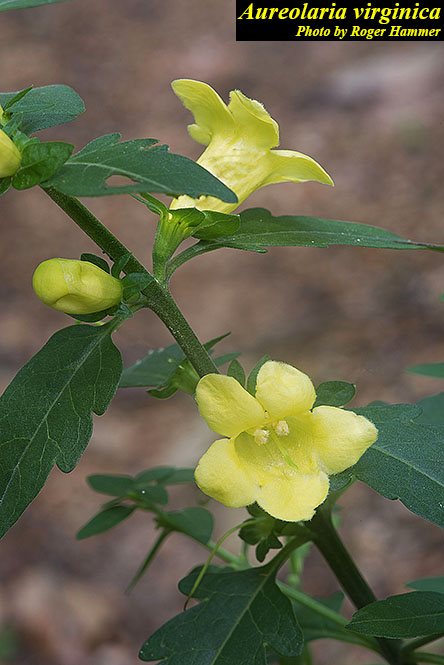Aureolaria virginica
| Aureolaria virginica | |
|---|---|

| |
| Photo by Roger Hammer, Atlas of Florida Vascular Plants | |
| Scientific classification | |
| Kingdom: | Plantae |
| Division: | Magnoliophyta - Flowering plants |
| Class: | Magnoliopsida - Dicotyledons |
| Order: | Scrophulariales |
| Family: | Scrophulariaceae |
| Genus: | Aureolaria |
| Species: | A. virginica |
| Binomial name | |
| Aureolaria virginica (L.) Pennell | |

| |
| Natural range of Aureolaria virginica from USDA NRCS Plants Database. | |
Common names: Downy yellow false foxglove; Downy oak-leech; Virginia oak-leech
Contents
Taxonomic notes
Synonyms: Gerardia virginica (Linnaeus) Britton, Sterns, & Poggenburg; A. microcarpa Pennell
Description
In the genus Aureolaria, the plants are either annual or perennial. They are parasitic on the roots of Quercus (oaks) and they turn black when dried. The cauline leaves are opposite or subopposite. The flowers are showy, the calyx is 5-parted, the lobes are shorter to longer than the tube. The corolla is yellow in color, bilabiate, and 5-parted. The tube is campanulate and the lobes are spreading. There are 4 stamens, didynamous, included, filaments are flattened, and the 2 longer more or less lanose. The anther sacs are basally awned. The stigma is capitate and exserted.[1]
Specifically for A. virginica, they’re perennial parasitic plants of the white oak group. The stems are pubescent, weakly branched or unbranched altogether, and grow to approximately 1 m or more tall. The leaves are lanceolate or ovate-lanceolate, entire or coarsely sinuate to pinnately lobed or parted, puberulent, or weakly tomentose, and most are 6-12 cm long, 1.5-4.5 cm wide. The terminal raceme has distinct, flowers that are solitary in the axils of opposite bracts. The pedicels are glabrous and most of the time less than 3 mm long at the anthesis. The calyx lobes are lanceolate, equaling or much longer than the tube, approximately 3-10 mm long, and is entire. The corolla is 3.5-4.5 cm long. The capsule is broadly ovoid, 1-1.5 mm long, are pubescent. The pedicels are 6 mm long. The seeds have several irregular, narrow, hyaline wings. Flowers from May to July; then August to September.[1]
Distribution
Listed as critically imperiled in New Hampshire, Vermont and Ontario.[2]
Ecology
Habitat
A. virginica grows in mixed deciduous oak forests in open habitats with well drained soil.[3]
Phenology
The yellow, flower blooms June through August.[4] This is a polycarpic, hemiparasitic species. It is hemiparasitic because it is autotrophic and able to grow to maturity without attaching to a host. Primary hosts include white oaks, however, Carya and Nyssa are also susceptible. A. virginica attaches to a host through modified roots called haustoria.[3]
Seed bank and germination
Seeds display innate dormancy, which can be broken by exposure of imbibed seeds to appropriate cold stratification conditions. Germination is epigeal with the radical emergence about four days after sowing.[3]
Pollination
Pollinated by Bombus.[3]
Conservation and management
Cultivation and restoration
Photo Gallery
References and notes
- ↑ 1.0 1.1 Radford, Albert E., Harry E. Ahles, and C. Ritchie Bell. Manual of the Vascular Flora of the Carolinas. 1964, 1968. The University of North Carolina Press. 956-7. Print.
- ↑ [[1]]NatureServe. Accessed: April 1, 2016
- ↑ 3.0 3.1 3.2 3.3 King, B. L. (1989). "Seed Germination Ecology of Aureolaria virginica (L.) Penn. (Scrophulariaceae)." Castanea 54(1): 19-28.
- ↑ [[2]]Lady Bird Johnson Wildflower Center. Accessed: April 1, 2016